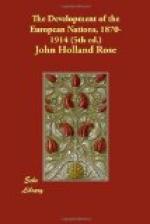This in itself was excellent “brokerage” on the French money, of which China was assumed to stand in need. At one stroke Russia ended the commercial supremacy of England in China, the result of a generation of commercial enterprise conducted on the ordinary lines, and substituted her own control, with powers almost equal to those of a Viceroy. They enabled her to displace Englishmen from various posts in Northern China and to clog the efforts of their merchants at every turn. The British Government, we may add, showed a singular equanimity in face of this procedure.
But this was not all. At the close of March 1896, it appeared that the gratitude felt by the Chinese Andromeda to the Russian Perseus had ripened into a definite union. The two Powers framed a secret treaty of alliance which accorded to the northern State the right to make use of any harbour in China, and to levy Chinese troops in case of a conflict with an Asiatic State. In particular, the Court of Pekin granted to its ally the free use of Port Arthur in time of peace, or, if the other Powers should object, of Kiao-chau. Manchuria was thrown open to Russian officers for purposes of survey, etc., and it was agreed that on the completion of the trans-Siberian railway, a line should be constructed southwards to Talienwan or some other place, under the joint control of the two Powers[491].
[Footnote 491: Asakawa, pp. 85-87.]
The Treaty marks the end of the first stage in the Russification of Manchuria. Another stage was soon covered, and, as it seems, by the adroitness of Count Cassini, Russian Minister at Pekin. The details, and even the existence, of the Cassini Convention of September 30, 1896, have been disputed; but there are good grounds for accepting the following account as correct. Russia received permission to construct her line to Vladivostok across Manchuria, thereby saving the northern detour down the difficult valley of the Amur; also to build her own line to Mukden, if China found herself unable to do so; and the line southwards to Talienwan and Port Arthur was to be made on Russian plans. Further, all these new lines built by




